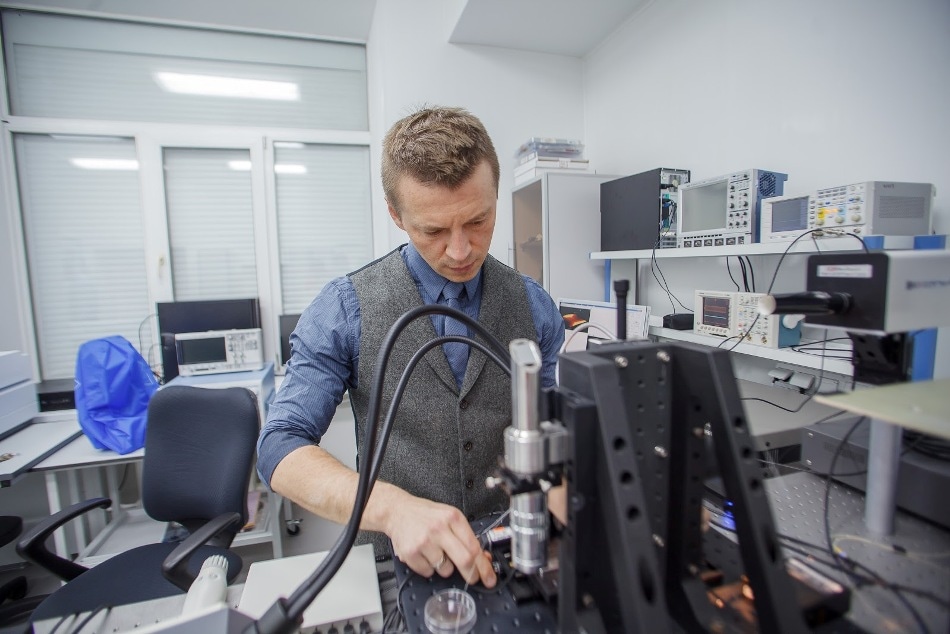Oct 19 2017
MIPT Scientists have performed ultra-precise evaluations of the optical constants of extremely thin gold films with thicknesses of 20-200 billionths of a meter in the optical range of the electromagnetic spectrum.
Thin gold films are important components of modern nano- and micro-scale optoelectronic and optical equipment. The outcomes of the study will be much sought after by other scientists in this area of research. The paper delineating the study was published in the Optics Express journal.
 Valentyn Volkov, the principal investigator, is the head of the Laboratory of Nanooptics and Plasmonics at MIPT.
Valentyn Volkov, the principal investigator, is the head of the Laboratory of Nanooptics and Plasmonics at MIPT.
Metal films that have a thickness of few tens of nanometers (i.e. tens of billionths of a meter) are broadly applied to develop compact photodetectors, chemical and biological sensors, components for optical computers, and solar cells. When nanofilms thinner than 10 nm are synthesized, they are conductive and also transparent and flexible, enabling them to be used in a broad range of modern equipment.
Gold, which is broadly applied in developing nanoscale devices, has been observed to be the most appropriate metal for this reason. Applications such as these mandate the use of gold as extremely thin films or nanostructures. In order to design and advance nanoscale devices, one needs to acquire accurate data on the characteristics of such films. However, much of the data applied by scientists now are outlined in papers published before nearly five decades. For example, “Optical constants of the noble metals” published in the year 1972 and written by P.B. Johnson and R.W. Christy is a frequently cited article for the optical constants of gold. According to the Scopus citation database, reference constants for gold from this article have been applied in nearly 10,000 other papers. In order to hold that work in high esteem, one must remember that analysis of the optical characteristics of thin metal films in the 1970s mandated immense effort because after the difficult experiments, it is more important to perform complicated computations without the use of computers.
Thinner is better
At present, the ultra-modern laboratory devices and the almost unrestricted computing power at the disposal of present-day scientists allow more in-depth investigations of thin metal films. Yet, it is well established that the optical characteristics of these films, and hence the efficaciousness of the devices dependent on them, are reliant on aspects such as deposition rate, film thickness, and the temperature of the substrate adopted for film deposition. Hence, the MIPT team slightly altered the original conditions (i.e. the substrate temperature and the deposition rate) to enhance the optical characteristics of the film. Following that, they performed the needed evaluations by adopting X-ray diffractometry, spectroscopic ellipsometry, as well as electron and atomic force microscopy. The acquired data enabled the MIPT researchers to carry out an in-depth analysis of the way the characteristics of thin gold films correspond to their average grain size and structure.
A material’s structure has a major impact on its physical characteristics as conduction electrons are scattered at grain boundaries and lose energy, similar to a ball in a pinball machine that loses its momentum when it encounters obstacles. Evidently, there is substantial increase in both optical losses and direct current resistivity when the thickness of the gold film decreased to less than 80 nm. The paper’s authors offer reference data on the optical constants of gold for a broad array of wavelengths (i.e. 300-2000 nm) for films having a thickness of 20-200 nm. The outcomes of the research can be used by scientists carrying out studies on different metamaterials and nanophotonic devices.
State-of-the-art technology
In order to develop thin films, the scientists adopted a method known as electron beam evaporation, where first a purified silicon substrate is placed inside a vacuum chamber. Then, a metal sample is positioned opposite to the substrate. Next, the metal, which here is gold, is treated with an electron beam accelerated through an electric field. Consequently, the gold is swiftly heated up, leading to melting of the gold and ultimately transformation of the gold into vapor. Subsequently, the evaporated gold atoms are conveyed across a low pressure region from their source and are condensed on the substrate to form the thin film.
Provided that you maintain a high vacuum, heat the metal appropriately, and otherwise follow the procedure, this technique yields films of arbitrary thickness, which is determined by the evaporation time. Moreover, the films are almost perfectly smooth, having a roughness of less than a nanometer. Such films can be used in optics and optoelectronics to develop high-sensitivity compact biosensors, solar cells, broadband photodetectors, and optoelectronic computer components.
Valentyn Volkov, Professor, The University of Southern Denmark and Head of the Laboratory of Nanooptics and Plasmonics at MIPT
These types of gold films that have a thickness of nearly 40 nm are already being used in biosensor design.